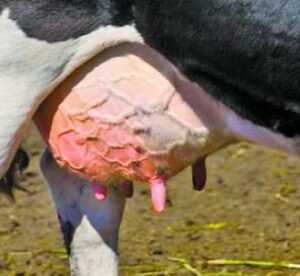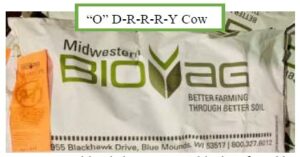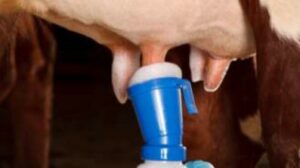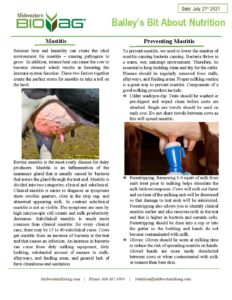Mastitus
Summer heat and humidity can create the ideal environment for mastitis-causing pathogens to grow. In addition, intense heat can cause the cow to become stressed which results in lowering the immune system function. These two factors together create the perfect storm for mastitis to take a toll on the herd.

Preventing Mastitus
To prevent mastitis, we need to lower the number of mastitis-causing bacteria causing. Bacteria thrive in a warm, wet, unkempt environment. Therefore, its essential to keep bedding clean and dry for the cattle. Manure should be regularly removed from stalls, alleyways, and feeding areas. A proper milking routine is a great way to prevent mastitis. Components of a good milking procedure include:
- Udder wash/pre-dip: Teats should be washed or pre-dipped and wiped clean before units are put on. Single-use towels should be used on each cow. Do not share towels between cows as this will spread mastitis.
- Forestripping: Removing 3-4 squirts of milk from each treat prior to milking helps stimulate the milk letdown Cows will milk out faster and on-time of the milking unit will be decreased so that damage to teat ends will be minimized. Forestripping also allows you to identify clinical mastitis earlier and also removes milk in the teat end that is higher in bacteria and somatic cells. Forestripping should be done into a cup or into the gutter so the bedding and hands do not become contaminated with milk.
- Gloves: Gloves should be worn at milking time to reduce the risk of spreading mastitis on Gloved hands are more easily disinfected between cows or when contaminated with milk or manure than bare skin.
- Milking order: Cows infected with mastitis should be identified permanently (leg bands) and milked last or with a unit designated just for them at each and every
- Overmilking/machine stripping: It is not necessary to get every drop of milk out of the cows Leaving the units on the cow when milk flow is low or pulling down on units will damage teat ends. When a unit is left on too long, keratin that develops at the teat end and has some natural anti-bacterial properties will be removed. Over milking will also cause eversion of the teat sphincter and development of scar tissue which leads to multiple problems. The teat sphincter and its ability to close between milkings is the first line of defense against mastitis. Scars and cracks that damage teat ends are more likely to be colonized by bacteria that will increase the risk of mastitis.
- Attention to post milking teat dipping: Attention to selection and application of post milking teat dip is of utmost importance in herds with If an uninfected cow is unknowingly milked after an infected cow, contagious bacteria are deposited on the milk film of the teats. There they will multiply and move toward the teat end in an attempt to infect. Applying post milking teat dip to at least 2/3 of each teat will kill bacteria before they have a chance to multiply and spread on the milk film. Teat dips should contain at least 10% teat skin conditioners to maintain udder health and prevent chapping and cracking.
The mechanical milking system should be evaluated by a qualified individual at least twice yearly. Vacuum fluctuations, due to liner slips, flooding, inadequate vacuum reserve, and poorly functioning regulators, are likely to force bacteria up the teat end during milking and increase the risk of mastitis. Rubber milking liners should be replaced every 800 cow milking’s or every 60 days, whichever comes first. The rubber used longer than this deteriorates and will develop microscopic cracks that hold mastitis bacteria even through the washing cycle. Other rubber parts (hoses, tubes, gaskets) should be inspected regularly and replaced when worn. Dry cow management and nutrition also play a role in mastitis prevention. The nutrition of a dry cow is important especially as she reaches the prefresh period. At this time, selenium and vitamin E levels become important for the support of the immune and reproductive systems and to ensure the birth of a vigorous calf. The recommended amount of selenium is 0.3 ppm per head per day and at least 1500IU of vitamin E per head per day to be fed. Good management, keeping cows cool, sanitation and cleanliness, and nutrition all help in preventing mastitis.

Dry cow nutrition is important at this time for udder health improvement and rejuvenation of milking tissue. “O” D-R-R-R-Y Cow is a mineral and vitamin product specifically formulated for conventional dry cow nutrition programs. This mineral provides balanced calcium and phosphorus source designed to complement late-maturing and grass-blend forages typically fed to dry cows. It also contains Icelandic kelp as a source of over 60 trace minerals and vitamins. Helps promote reproductive health, hoof health, and immune system function. Contains yeast culture to help stabilize rumen fermentation and help the rumen recuperate and regenerate for the next lactation. This mineral meets daily trace mineral and vitamin needs, including vitamins A, D3, E and B complex. Contains selenium derived from selenium yeast to help support the immune system.



